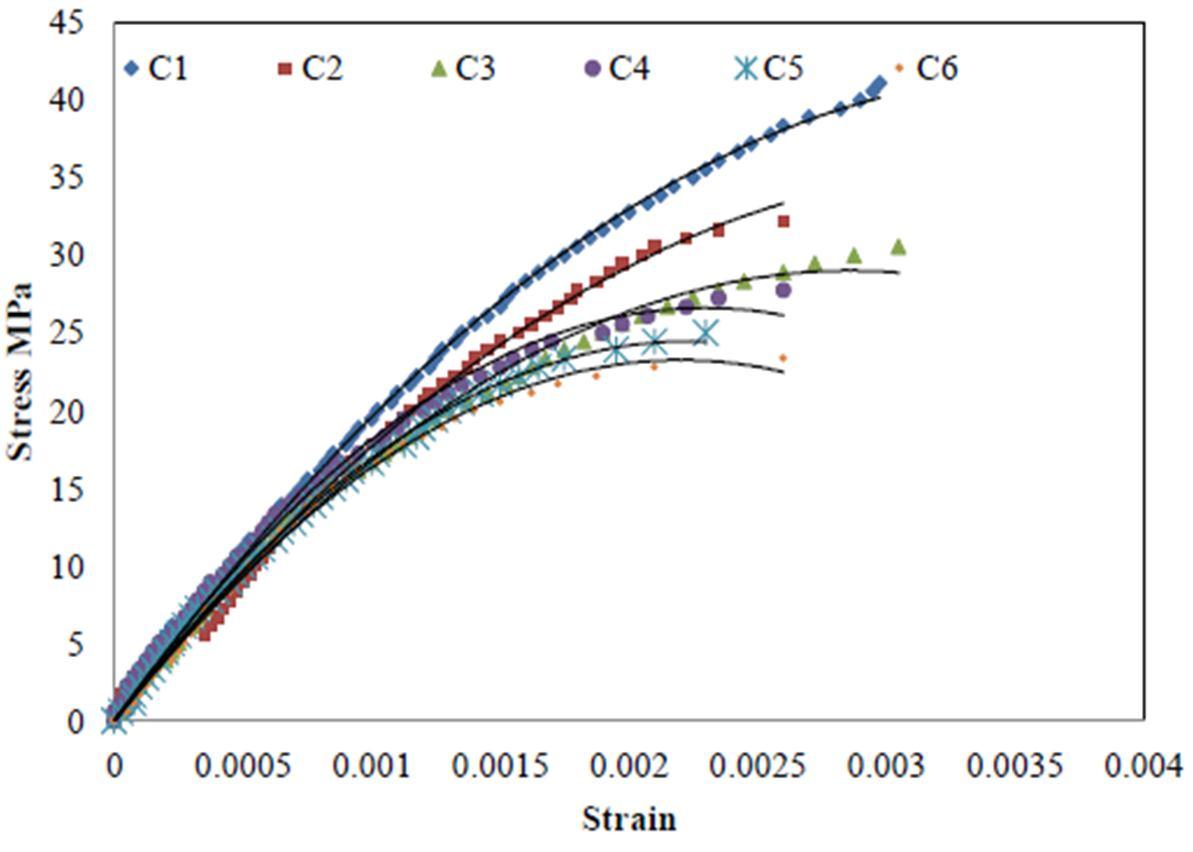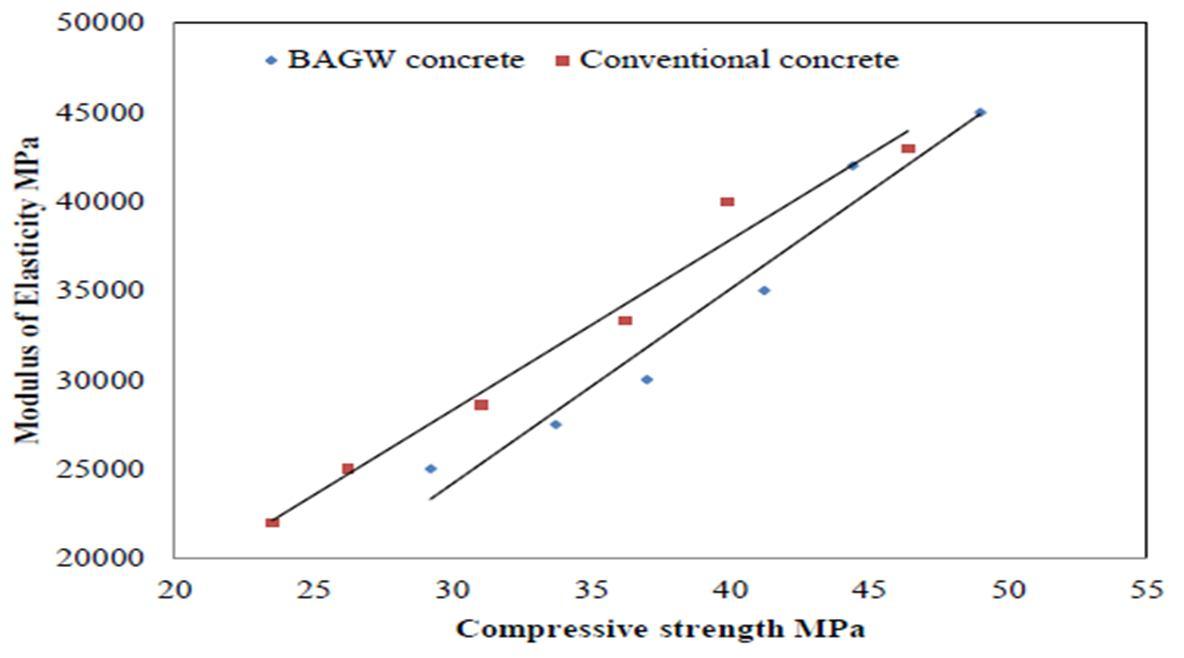
5 minute read
Dilip Kumar Singha Roy, (2012) have studied the strength parameters of concrete made with partial replacement of cement by silica fume for low/medium-grade concretes (M20 and M25). They concluded that the use of silica fume is a necessity in the production of not only high strength concrete but also low/medium strength concrete at lower w/c ratio and better hydration of cement particles including strong bonding amongst the particles. The maximum compressive strength (both cube and cylinder) is noted for replacement of cement with silica fume and the values are higher (by 19.6% and 16.82% respectively) than control concrete, whereas split tensile strength and flexural strength of the SF concrete are increased by about 38.58% and 21.13% respectively than by the control of concrete when 10% of cement is replaced by silica fume.
from Experimental Investigation on the use of Sugarcane Bagasse Ash Granite Waste as Fine Aggregate
by IJRASET
E. Modulus of Elasticity
Figure 8. Relationship between Compressive Stress and Strain for BAGW Concrete
Advertisement
Figure 9. Relationship between Compressive Stress and Strain for Conventional Concrete
Figure 10. Relationship between Modulus of Elasticity and 28 days Compressive Strength


Discussions: Modulus of elasticity in direct compression of concrete was calculated with initial tangent modulus from the stress-strain curve of BAGW and conventional concretes. Fig. 8 and 9 shows the compressive stress-strain behavior of the
BAGW and conventional concretes respectively. The modulus of elasticity of BAGW concrete ranged from 45-25GPa and for conventional concrete is 43-22GPa. The value of BAGW concrete is 5-13.6% higher than the conventional concrete. The stressstrain behavior of Bagasse ash and granite waste as fine aggregate concrete is slightly higher than the conventional concrete.
The expression for determining the modulus of elasticity for BAGW concrete using 28 days compressive strength is presented.
For determining the modulus of elasticity depending on the compressive strength at 28 days obtained from the test results are given below. From the experimental results, it is revealed that the modulus of elasticity affects the concrete compressive strength as shown in Fig. 10. The modulus of elasticity increases when the compressive strength is increased.
VI. CONCLUSIONS
1) The slump value of the concrete mixture was decreased when river sand is replaced with combined Bagasse ash and granite waste, because of the fine particle content in SCBA It shows that concrete is significantly stiff and hard to compact to improve the workability of BAGW concrete, superplasticizer should be used without increasing the water. 2) The basic trend in the variation of the strength of BAGW concrete with the water cement-ratio is similar to that of the conventional concrete. So, SCBA and GW can be used as the fine aggregate in concrete making. The basic water-cement ratio law can be applied to BAGW concrete. 3) The mechanical properties of BAGW concrete are comparable to those of conventional concrete. 4) Because of the pozzolanic nature of SCBA, the early age strength is lower than that of the conventional concrete but later age strength of BAGW concrete is higher than that of the conventional concrete. So the rate of development of strength of BAGW concrete is varying from the conventional concrete. 5) The relationships has been proposed between cube compressive and split tensile strength and cube compressive and flexural strength of BAGW concrete. 6) At 28days split tensile strength of BAGW concrete is 17 – 31% increase in strength than the conventional concrete. The tensile to compressive strength ratio was higher for BAGW concrete compared to the conventional concrete. 7) The ratio of flexural strength (Modulus of rupture) to compressive strength is lower for BAGW concrete. The flexural strength of BAGW is 2.9-12.8% higher than the conventional concrete. 8) The trend in stress-strain behavior of BAGW concrete at compression is similar to conventional concrete up to ultimate load.
The modulus of elasticity of BAGW concrete is slightly higher than the conventional concrete.
REFERENCES
[1] Bouzoubaa, N, Zhang, M.H & Malhotra, V.M, Mechanical properties and durability of concrete made with high-volume fly ash blended cements using a coarse fly ash, “Cement and Concrete Research”, vol.31, no. 10, pp. 1393-1402 (2001). [2] Chindaprasirt, P & Rukzon, S, Strength, porosity and corrosion resistance of ternary blend Portland cement, rice husk ash and fly ash mortar‘, “Construction and Building Materials”, vol. 22, no. 8, pp. 1601-1606 (2008). [3] Chindaprasirt, P, Homwuttiwong, S & Jaturapitakkul, C, Strength and water permeability of concrete containing palm oil fuel ash and rice husk–bark ash‘,
“Construction and Building Materials”, vol. 21, no. 7, pp. 1492-1499 (2007). [4] Chindaprasirt, P, Rukzon, S & Sirivivatnanon, V, Resistance to chloride penetration of blended Portland cement mortar containing palm oil fuel ash, rice husk ash and fly ash‘, “Construction and Building Materials”, vol. 22, no. 5, pp. 932-938 (2008). [5] Chuanlin, Hu & Zongjin, Li, Property investigation of individual phases in cementitious composites containing silica fume and fly ash‘, Cement & Concrete
Composites, vol. 57, pp. 17-26 (2015). [6] Deepa G. Nair, Jagadish, K.S & Alex Fraaij, Reactive pozzolanas from rice husk ash: An alternative to cement for rural housing‘, “Cement and Concrete
Research”, vol.36, no. 6, pp. 1062-1071. (2006). [7] Della, V. P., Kühn I & Hotza D, RHA as an alternate source for active silica production, “Journal of material science”, Vol. 57, pp. 818-821 (2002). [8] Dinakar, P, Babu, KG & Manu Santhanam, Durability properties of high volume fly ash self- compacting concretes‘, “Cement& Concrete Composites”, vol. 30, no. 10, pp. 880-886 (2008). [9] Duran-Herrera, A, Juarez, CA, Valdez, P & Bentz, DP, Evaluation of sustainable high-volume fly ash concretes‘, “Cement & Concrete Composite”s, vol. 33, no. 1, pp. 39-45 (2011). [10] Feldman, RF, Carette, GG & Malhotra, VM, Studies mechanism of development of physical and mechanical properties of high volume fly ash cement paste‘,
“Cement and Composites”, vol. 12, no. 4, pp. 245-251. (1990). [11] Ganesan, K, Rajagopal, K & Thangavel, K, Chloride resisting concrete containing rice husk ash and bagasse ash‘, Indian Journal of Engineering and Materials
Science, vol. 14, pp. 125-130 (2007). [12] Gastaldini, ALG, Da Silva, MP, Zamberlan, FB & Mostardeiro Neto, CJ, Total shrinkage, chloride penetration, and compressive strength of concretes that contain clear-colored rice husk ash‘, “Construction and Building Materials”, vol. 54, pp. 369-377. (2014).



